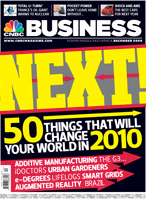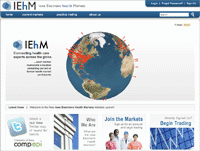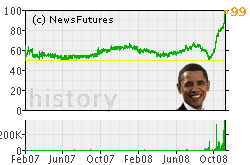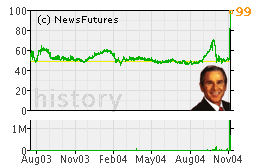 Today Queen Beatrix of Holland officially asked prime minister Jan Peter Balkenende to head a newly formed coalition government, and so we closed down the Dutch Political Prediction Market that we had been operating for de Volkskrant. The election actually took place three months ago, on November 22, but the process of negotiating a new three-way governing coalition proved arduous. It’s time to assess the market’s behavior.
Today Queen Beatrix of Holland officially asked prime minister Jan Peter Balkenende to head a newly formed coalition government, and so we closed down the Dutch Political Prediction Market that we had been operating for de Volkskrant. The election actually took place three months ago, on November 22, but the process of negotiating a new three-way governing coalition proved arduous. It’s time to assess the market’s behavior.
The market proposed three sets of contracts to predict the following:
1) Vote shares for thirteen political parties on election day: linear-payoff contracts, 0.01 euro per percentage point. We set maximum payoff caps for these contracts in an attempt to make shorting affordable in the case of small parties. For instance, the SP contract (Socialist Party) had a maximum payoff of 0.15 euro because de Volkskrant’s political experts estimated that SP could not score more than 15% of the vote in any case.
2) Which of eighteen possible coalitions might to form a new government: binary contracts, 1 euro for the winner, 0 for the losers.
3) Who would become the next prime minister: binary contracts, 1 euro for the winner, 0 for the losers.
For each of these groups of contracts, participants could buy a full set (a “basket”) for 1 euro, just as is customary on the IEM. They could also short and cover individual contracts.
Participants could deposit up to 100 euro ($130) into their accounts. In all, about 90,000 euro was deposited into some 1,800 accounts.
Predicting Vote Share
The big surprise of this election – every election has one – turned out to be the big gains registered by the Socialist Party (SP). It scored over 17% of the vote when, a month earlier, everyone expected it to score at most 13%, and it became the third largest party in parliament. No one saw that coming until just before the election: not the experts, not the polls, and not the market. In fact, because the experts were so wrong, we had miscalibrated the maximum payoff cap of the SP contract at 0.15 euro, thus making it incapable of producing a correct prediction in any case. We should have known better than to trust experts!
Because the SP contract was so badly calibrated, we compared the market and the polls on the other three big parties only. At first glance, the quality of the market’s vote share predictions were somewhat disappointing compared to the three main polls: Over the week that preceded the election, the polls, as a group tended to be more accurate than the market, as summarized below:

However, the story changes dramatically if, instead of looking at the predictions just before the election, we consider the predictions several weeks earlier. Four to seven weeks before election day (i.e, throughout October), the polls were much less reliable and the market clearly out-predicted them, individually and as a group.

Now, whether we think this is a good result or a bad result depends on whether we think that it is more useful to predict elections just one week ahead or several weeks ahead…
Predicting the winning coalition
A very interesting thing happened on election day, once it became clear that the two biggest parties, CDA and PvdA, did not win enough seats in parliament to form a coalition together. A governing coalition would need to involve at least three parties, and negotiations promised to be arduous… However, as the chart below shows quite clearly, the market immediately expressed a strong preference for the CDA-PvdA-CU coalition (green curve), even-though the politicians, for their part, rejected that possibility and preferred to start negotiations for another coalition: CDA-PvdA-SP (orange curve). Those negotiations collapsed within a couple of weeks, and the politicians eventually agreed to form the coalition that traders had envisioned on election day.

Predicting the prime minister
In the end, outgoing Prime Minister Jan Peter Balkenende (CDA) kept his job. It is clear from the chart below that he had the market’s preference almost from the beginning and throughout.

For those who want to dig deeper into Dutch politics and the results of this latest election, we recommend the excellent wikipedia entry.
























 Emile is presenting a
Emile is presenting a 





 Over the weekend, the Financial Times published a great
Over the weekend, the Financial Times published a great 

 But even that misses the point of why people should play real-money political markets, like
But even that misses the point of why people should play real-money political markets, like  When it comes to political elections, most people feel quite like those helpless rats receiving uncontrollable shocks. Your individual vote, if you even have one, doesn’t amount to any kind of meaningful control over the outcome, even though this outcome can be extremely aggravating emotionally, financially, and/or physically if the wrong person wins. The resulting stress can reduce your ability to fight diseases, as it does in rats.
When it comes to political elections, most people feel quite like those helpless rats receiving uncontrollable shocks. Your individual vote, if you even have one, doesn’t amount to any kind of meaningful control over the outcome, even though this outcome can be extremely aggravating emotionally, financially, and/or physically if the wrong person wins. The resulting stress can reduce your ability to fight diseases, as it does in rats.


 Later this week, NewsFutures will have another great opportunity to introduce prediction markets into the consciousness of mighty American businessmen and women.
Later this week, NewsFutures will have another great opportunity to introduce prediction markets into the consciousness of mighty American businessmen and women. The event will be held at the famous
The event will be held at the famous 

 She was billed as the only one who could steal this election from Nicolas Sarkozy. The media had dubbed her “the queen of the polls”, so towering was her popularity over her socialist rivals for the party’s nomination. She was strikingly beautiful (for a politician), feminine yet tough, motherly yet authoritative, reassuring yet unafraid to break taboos. She was all at once
She was billed as the only one who could steal this election from Nicolas Sarkozy. The media had dubbed her “the queen of the polls”, so towering was her popularity over her socialist rivals for the party’s nomination. She was strikingly beautiful (for a politician), feminine yet tough, motherly yet authoritative, reassuring yet unafraid to break taboos. She was all at once 
 After the debate, the pundits were all agreed that Royal had scored some points, and even die-hard Sarkozy fans openly worried that Royal had bested their champion. The next morning, newspapers and radio stations still conveyed the impression that Royal’s performance had probably helped her. However, the trading pattern one could observe on NewsFutures and other prediction markets told a different story altogether. The price of Sarkozy’s contract actually rose a little during the debate and just after, as evidenced in the chart at left. The next morning, this gain held, even as political pundits on the radio stations were still praising Royal’s performance. The disconnect continued until the afternoon, when the results of a poll taken just after the debate showed that it was Sarkozy that had come out on top, confirming the market’s impression.
After the debate, the pundits were all agreed that Royal had scored some points, and even die-hard Sarkozy fans openly worried that Royal had bested their champion. The next morning, newspapers and radio stations still conveyed the impression that Royal’s performance had probably helped her. However, the trading pattern one could observe on NewsFutures and other prediction markets told a different story altogether. The price of Sarkozy’s contract actually rose a little during the debate and just after, as evidenced in the chart at left. The next morning, this gain held, even as political pundits on the radio stations were still praising Royal’s performance. The disconnect continued until the afternoon, when the results of a poll taken just after the debate showed that it was Sarkozy that had come out on top, confirming the market’s impression.
 Today Queen Beatrix of Holland officially asked prime minister Jan Peter Balkenende to head a newly formed coalition government, and so we closed down the
Today Queen Beatrix of Holland officially asked prime minister Jan Peter Balkenende to head a newly formed coalition government, and so we closed down the 



 A
A 